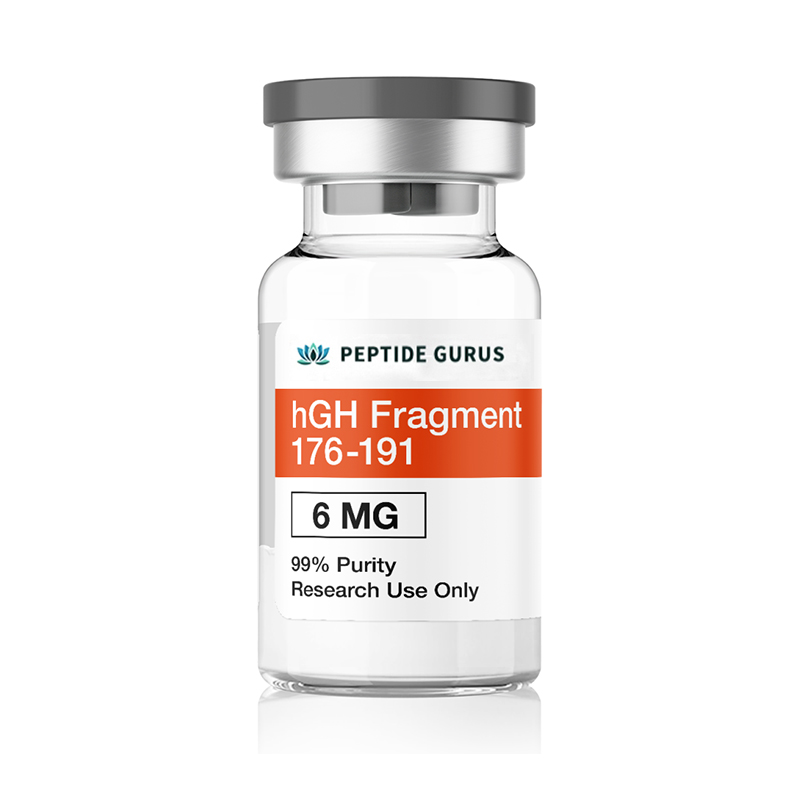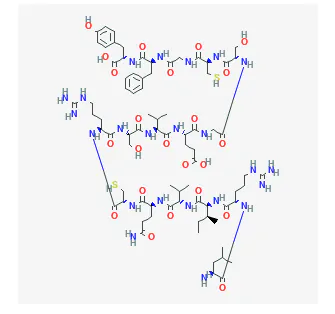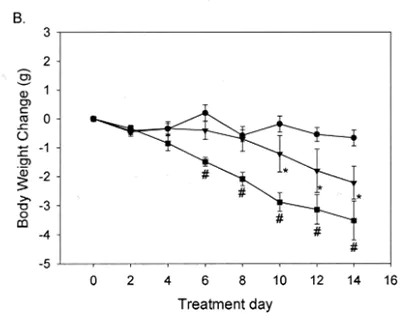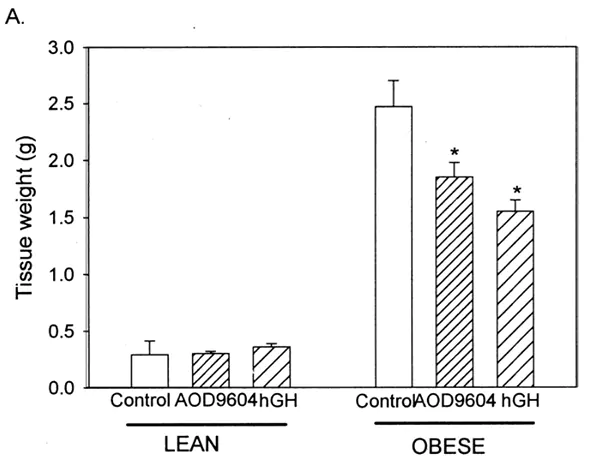



Kategori:Produk jadi peptida, Peptida dan dosisnya
Bebas (1) 30 mL air bakteriostatik
dengan pesanan yang memenuhi syarat$ 500 USD.
(Tidak termasuk produk kapsul, peptida kosmetik, kode promo dan pengiriman)
Fragmen HGH 176-191adalah bagian kecil, sintetis hormon pertumbuhan manusia alami (HGH). Ini sering disebut sebagai "fragmen lipolitik" karena kemampuannya untuk meningkatkan kehilangan lemak. Telah terbukti membantu menurunkan kadar gula darah dan meningkatkan penyembuhan tulang rawan tanpa meningkatkan pertumbuhan tulang yang panjang, meningkatkan kadar IGF-1, atau mengubah sensitivitas insulin.
Penggunaan Produk:Produk ini dimaksudkan sebagai bahan kimia penelitian saja.Penunjukan ini memungkinkan penggunaan bahan kimia penelitian secara ketat hanya untuk pengujian in vitro dan eksperimen laboratorium saja. Semua informasi produk yang tersedia di situs web ini hanya untuk tujuan pendidikan. Pengenalan tubuh dalam bentuk apa pun ke dalam manusia atau hewan dilarang secara ketat oleh hukum. Produk ini hanya boleh ditangani oleh profesional berlisensi dan berkualifikasi. Produk ini bukan obat, makanan, atau kosmetik dan mungkin tidak disalahgunakan, disalahgunakan, atau disesatkan sebagai obat, makanan atau kosmetik.
Fragment 176-191 (versi yang dimodifikasi OfAOD9604) adalah bagian kecil hormon pertumbuhan manusia (HGH) yang kadang-kadang disebut sebagai "fragmen lipolitik." Fragmen 176-191 mendapatkan nama terakhir ini karena fakta bahwa penelitian laboratorium telah menunjukkannya untuk meningkatkan pembakaran lemak, terutama pada tikus yang direkayasa secara genetik untuk menghasilkan penyimpanan lemak besar. Fragmen 176-191 telah banyak diteliti pada model hewan karena bahkan sementara itu mempertahankan efek pembakaran lemak dari HGH, ia menghindari beberapa efek lain dari protein induknya seperti meningkatkan kadar faktor pertumbuhan seperti insulin (IGF-1), yang berdampak negatif terhadap metabolisme karbohidrat, mengubah sensitivitas insulin, dan meningkatkan pertumbuhan tulang yang panjang. Efek yang ditargetkan dari fragmen 176-191 membuatnya berguna untuk mengeksplorasi metabolisme lemak manusia dan pada akhirnya dapat memberikan dasar untuk mengembangkan obat anti-obesitas.

Sumber:Pubch
Urutan:Tyr-leu-arg-Ile-val-gln-cys-arg-ser-val-glu-gly-ser-cys-gly-phe
Formula Molekul:C78H125N23O23S2
Berat molekul:1817.12 g/mol
Nomor CAS:66004-57-7
Penelitian pada hewan telah mengungkapkan bahwa ujung C-terminal HGH terutama bertanggung jawab atas efek hipoglikemik protein (menurunkan gula darah). Pengujian setidaknya enam fragmen berbeda yang berasal dari bagian HGH ini telah menunjukkan bahwa fragmen 176-191 adalah turunan sintetis HGH yang paling efektif untuk menurunkan kadar gula darah. Efek ini sekunder untuk peningkatan kadar insulin plasma yang berkelanjutan[1]. There is some interest in using fragment 176-191 as a treatment for both prediabetes and type 2 diabetes.
Fragment 176-191 has earned the nickname of “lipolytic fragment” because testing in mice has revealed the peptide to have substantial fat burning and weight loss properties. It is thought that this action is mediated through an increase in production of beta-3 adrenergic receptors (β3-AR or ADRB3)[2]. Agonist action at ADRB3 is known to directly increase fat burning in adipose tissue and is also responsible for thermogenesis in skeletal muscle[3]. Mice that have been genetically modified to produce no ADRB3 do not respond to the lipolytic effects of hGH or fragment 176-191[2].
Studies show that the increased fat burning associated with fragment 176-191 directly correlates with energy expenditure and thus weight reduction, leading to a nearly 50% reduction in weight gain in obese animals over a three-week course[4]. Interestingly, the weight loss effects were seen only in obese mice, with lean mice maintaining normal body weight, on average, even when exposed to fragment 176-191[2]. These findings indicate that there are secondary regulatory pathways for lipolysis that override ADRB3 function when body weight is at or near ideal, opening up areas for additional research into energy homeostasis.

Body weight in genetically obese mice after two weeks of treatment with a single daily dose of fragment 176-191
Source: Oxford Academic

Effect of saline (control), fragment 176-191, and hGH on white adipose tissue mass in obese mice over 14 days
Source: Oxford Academic
Though fragment 176-191 is primarily of interest for its lipolytic properties, the peptide is under investigation for other possible benefits. Of note, a 2015 article out of Korea revealed that fragment 176-191 may be able to potentiate the effects of hyaluronic acid injections in promoting cartilage regeneration. Studies in rabbits indicated that weekly injections of fragment 176-191 increase laboratory measures of cartilage growth and that co-administration of the peptide with hyaluronic acid (HA) produces even more substantial effects. Similarly, the study found that fragment 176-191, both alone and in combination with HA, reduces disability associated with osteoarthritis. There is hope that this may lead to advanced therapies for osteoarthritis and may even eliminate the need for surgery in certain settings[7].
There is some concern that the use of hGH or its derivatives for weight control may have unwanted side effects. This concern arises from the fact that studies of hGH have shown that long-term exogenous administration, while increasing lean body mass and decreasing adipose tissue, can also cause:
In 2013, a study published in the Journal of Endocrinology and Metabolism evaluated six studies of fragment 176-191 to assess the rate and significance of negative effects associated with the peptide. The study, included only research that followed the randomized, double-blinded, placebo-controlled model of a phase IIb clinical trial in order to keep the highest possible standards of evidence. It found that IV and oral administration of Fragment 176-191, when compared to placebo, led to no changes in:
The results of this meta-analysis suggest that fragment 176-191 offers many of the benefits of hGH without the associated negative (and often serious) side effects. These findings further the argument for pursuing regulatory approval for use of fragment 176-191 in the clinical setting, but also offer insight into the regulation of human growth, fat deposition, and energy homeostasis. These findings make it clear that it is possible to target fat loss without affecting energy homeostasis in other nutrient pathways, opening the door for a deeper exploration of human energy regulation and methods of manipulating it.
It is worth noting that while hGH has anabolic effects on muscle, fragment 176-191 was specifically selected for its ability to avoid anabolism entirely. This is critical to ensuring that the peptide has targeted lipolytic effects and does not produce acromegaly or any of the other conditions associated with hGH administration. Studies in mice reveal that fragment 176-191 does not increase cell proliferation[6].
The primary area of research for fragment 176-191 is in weight loss and lipolysis where significant effort is being expended to learn how the peptide can be used to understand fat metabolism and energy homeostasis. The most active secondary area of research is in connective tissue regeneration, particularly cartilage repair.
The above literature was researched, edited and organized by Dr. Logan, M.D. Dr. Logan holds a doctorate degree from Case Western Reserve University School of Medicine and a B.S. in molecular biology.
Frank NG, M.D. is one of the leading scientists discovering how both AOD9604 and Fragment 176-191 function. He extensively studied their effects on lipid metabolism in obese mice, fat oxidation, weight loss, oral digestion, glucose transport, and hyperglycemia. He has over 64 publications and studies at the Department of Biochemistry and Molecular Biology — Monash University, Australia.
Frank NG, M.D. is being referenced as one of the leading scientists involved in the research and development of Fragment 176-191. In no way is this doctor/scientist endorsing or advocating the purchase, sale, or use of this product for any reason. There is no affiliation or relationship, implied or otherwise, between
ALL ARTICLES AND PRODUCT INFORMATION PROVIDED ON THIS WEBSITE ARE FOR INFORMATIONAL AND EDUCATIONAL PURPOSES ONLY.
The products offered on this website are furnished for in-vitro studies only. In-vitro studies (Latin: in glass) are performed outside of the body. These products are not medicines or drugs and have not been approved by the FDA to prevent, treat or cure any medical condition, ailment or disease. Bodily introduction of any kind into humans or animals is strictly forbidden by law.
PeptideGurus is a leading supplier of American-made research peptides, offering top-quality products at competitive prices. With a focus on excellence and customer service, they ensure a secure and convenient ordering process with global shipping.
CONTACT